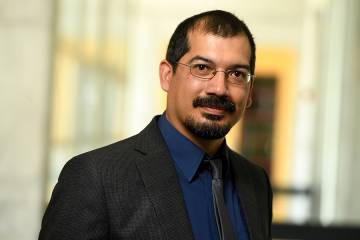Oil refineries and chemical manufacturing plants are known for their meandering pipes, billowing smokestacks, and fumes. They don't make the best neighbors, but they do make many products that a modern lifestyle depends on.
Michael Tsapatsis, an innovative chemical engineer and materials scientist who joined Johns Hopkins University this month as a Bloomberg Distinguished Professor, is very familiar with the internal workings of these plants.
"A challenge for the U.S. chemical industry is to continue increasing profits while improving safety and reducing its environmental impact," Tsapatsis says. "My group is advancing the frontier of designing new materials that can produce more of the desirable products with less waste, carbon footprint, and energy consumption."
Tsapatsis is an expert on materials that have pores of molecular size. These so-called molecular sieves are used as catalysts to speed up desirable chemical transformations, and as adsorbents that selectively trap and remove pollutants. By combining chemical engineering principles with advanced computations and synthetic chemistry, Tsapatsis and his research group are designing and synthesizing the next generation of molecular sieves.
The team created zeolite nanosheets, the equivalent of a filter paper that is extremely thin—10,000 times thinner than a piece of paper—with tiny, precisely sized pores that are 100,000 smaller than a human hair. When stitched together with methods pioneered by Tsapatsis' group, they form unique membranes that efficiently purify chemicals and can create more efficient refineries and cleaner air.
"Our membranes hold the world record in performance but, much like a Formula One race car, they are not ready for mass production," Tsapatsis says. "Our next challenge is how to incorporate elements of these discoveries in low-cost reliable devices that can be adopted by the chemical industry and beyond."
The Sept. 7 edition of Science features the latest research from the Tsapatsis group: a novel thin-film deposition method for making metal-organic-framework membranes.
"MOFs, like zeolites, are molecular sieves," Tsapatsis says. "They offer tremendous flexibility in rationally tuning their pore size to the specific application. However, up to now, MOF membrane formation relied in tedious and costly methods. This is a long-awaited breakthrough that will provide a simple, reliable, and scalable method and may open a new era in MOF membranes."
Tsapatsis joined Johns Hopkins after 15 years at the University of Minnesota, where he was a member of the Department of Chemical Engineering and Materials Science. He is the university's 36th Bloomberg Distinguished Professor, taking his place among an interdisciplinary group of scholars who are working to address global challenges and teach the next generation. The program is backed by a $350 million gift from Johns Hopkins alum, philanthropist, and three-term New York City Mayor Michael R. Bloomberg.
At Hopkins, Tsapatsis is a tenured professor in the Whiting School of Engineering's Department of Chemical and Biomolecular Engineering with a joint appointment in the Applied Physics Laboratory's Research and Exploratory Development Department.
"Dr. Tsapatsis is a charismatic and an internationally sought-after lecturer," says Sunil Kumar, provost and senior vice president for academic affairs at Johns Hopkins. "We envision him building broad-appeal courses for students across engineering and sciences that will introduce them to a wide array of cutting-edge concepts pertinent to nanoparticles and nanocomposites for energy and membrane applications."
In addition to moving his lab to Hopkins, Tsapatsis will teach courses for both undergraduate and graduate students. An experienced teacher, he is known for leading a broad set of core and elective engineering and physical chemistry courses reflecting his interests in reaction engineering, catalysis, separations, transport phenomena, process, and product design with an emphasis on energy efficiency and process intensification.
He says he is looking forward to collaborating with colleagues at Hopkins and exploring new applications for porous materials beyond those in the chemical industry. Working with APL will allow him to bridge the gap between the lab and demonstrating the value of his designs to the potential users through rapid prototyping and incorporation in devices.
"Having Dr. Tsapatsis join Johns Hopkins expands our ability to conduct groundbreaking research in the area of nanoparticles and nanocomposites," says Ed Schlesinger, dean of the Whiting School. "Dr. Tsapatsis is a leading researcher in the field of zeolite membranes, which have important industrial applications. We expect his work will enable productive collaborations, not just between our Chemical and Biomolecular Engineering department and the Applied Physics Laboratory, but also with our large materials engineering efforts as well as with industrial partners."
Tsapatsis received a diploma in chemical engineering from the University of Patras in Patras, Greece, in 1988. He then traveled to the United States to study at the California Institute of Technology, where he earned both his master's degree and PhD in chemical engineering in 1991 and 1994, respectively. He was also a post-doctoral fellow at Caltech.
Tsapatsis has published more than 250 papers, given numerous presentations around the world, and in 2015 was elected member of the National Academy of Engineering for his contributions to the "design and synthesis of zeolite-based materials for selective separation and reaction."
His wife, Efie Kokkoli, an expert in targeted drug and gene delivery, was also recruited from the University of Minnesota by Hopkins, where she will be a professor in the Department of Chemical and Biomolecular Engineering and the Institute of NanoBioTechnology.
"Michael is a renowned materials scientist whose groundbreaking work has had tremendous impact across the research community, industry, and society," APL Director Ralph Semmel says. "As we further strengthen our capabilities and leadership in the development and application of advanced materials, his contributions will help us solve some of the nation's most critical technical challenges."











